McConnell Campbell R., Brue Stanley L., Barbiero Thomas P. Microeconomics. Ninth Edition
Подождите немного. Документ загружается.


tomato farmer, the market period may be a full growing season; for producers of
goods that can be inexpensively stored, there may be no market period at all.
Price Elasticity of Supply: The Short Run
In the short run, the plant capacity of individual producers and of the entire industry
is fixed. Even so, firms do have time to use their fixed plants more or less intensively.
In the short run, our farmer’s plant (land and farm machinery) is fixed, but time is
available in the short run to cultivate tomatoes more intensively by applying more
labour and more fertilizer and pesticides to the crop. The result is a somewhat greater
output in response to a presumed increase in demand; this greater output is reflected
in a more elastic supply of tomatoes, as shown by figure S
s
in Figure 6-3(b). Note now
that the increase in demand from D
1
to D
2
is met by an increase in quantity (from Q
0
to Q
s
), so there is a smaller price adjustment (from P
0
to P
s
) than in the market period.
The equilibrium price is, therefore, lower in the short run than in the market period.
Price Elasticity of Supply: The Long Run
The long run is a period long enough for firms to adjust their plant sizes and for new
firms to enter (or existing firms to leave) the industry. In the tomato industry, for
example, our farmer has time to acquire additional land and buy more machinery
and equipment. Furthermore, other farmers may, over time, be attracted to tomato
farming by the increased demand and higher price. Such adjustments create a larger
supply response, as represented by the more elastic supply curve S
L
in Figure 6-3(c).
The outcome is a smaller price rise (P
0
to P
1
) and a larger output increase (Q
0
to Q
1
)
in response to the increase in demand from D
1
to D
2
. (Key Question 10)
There is no total-revenue test for elasticity of supply. Supply shows a positive or
direct relationship between price and amount supplied; the supply curve is upslop-
ing. Regardless of the degree of elasticity or inelasticity, price and total revenue
always move together.
Price elasticities measure the responsiveness of the quantity of a product demanded
or supplied when its price changes. The consumption of a good also is affected by
a change in the price of a related product or by a change in income.
Cross Elasticity of Demand
The cross elasticity of demand measures how sensitive consumer purchases of one
product (say, X) are to a change in the price of some other product (say, Y). We cal-
culate the coefficient of cross elasticity of demand E
xy
just as we do the coefficient of
simple price elasticity, except that we relate the percentage change in the consump-
tion of X to the percentage change in the price of Y:
E
xy
=
This cross elasticity (or cross price elasticity) concept allows us to quantify
and more fully understand substitute and complementary goods, introduced in
Chapter 3.
percentage change in quantity demanded of product X
ᎏᎏᎏᎏᎏᎏᎏ
percentage change in price of product Y
140 Part Two • Microeconomics of Product Markets
short run A
period of time in
which producers
are able to change
the quantities of
some but not all of
the resources they
employ.
long run A
period of time long
enough to enable
producers of a
product to change
the quantities of all
the resources they
employ.
cross
elasticity
of demand
The ratio of the
percentage change
in quantity
demanded of one
good to the percent-
age change in the
price of some other
good; a positive
coefficient indicates
the two products are
substitute goods; a
negative coefficient
indicates they are
complementary
goods.
Cross Elasticity and Income
Elasticity of Demand

SUBSTITUTE GOODS
If cross elasticity of demand is positive, meaning that sales of X move in the same
direction as a change in the price of Y, then X and Y are substitute goods. An exam-
ple is Kodak film (X) and Fuji film (Y). An increase in the price of Kodak film causes
consumers to buy more Fuji film, resulting in a positive cross elasticity. The larger
the positive cross elasticity coefficient, the greater the substitutability between the
two products.
COMPLEMENTARY GOODS
When cross elasticity is negative, we know that X and Y move together; an increase
in the price of one decreases the demand for the other. They are complementary
goods. For example, an increase in the price of cameras will decrease the amount of
film purchased. The larger the negative cross elasticity coefficient, the greater is the
complementarity between the two goods.
INDEPENDENT GOODS
A zero or near-zero cross elasticity suggests that the two products being considered
are unrelated or independent goods. An example is walnuts and film; we would not
expect a change in the price of walnuts to have any effect on purchases of film, and
vice versa.
APPLICATIONS
The degree of substitutability of products, measured by the cross elasticity coeffi-
cient, is important to businesses and government. For example, suppose that Coca-
Cola is considering whether to lower the price of its Sprite brand. Not only will it
want to know something about the price elasticity of demand for Sprite (will the
price cut increase or decrease total revenue?), it will also be interested in knowing
whether the increased sale of Sprite will come at the expense of its Coke brand. How
sensitive are the sales of one of its products (Coke) to a change in the price of
another of its products (Sprite)? By how much will the increased sales of Sprite can-
nibalize the sales of Coke? A low cross elasticity would indicate that Coke and Sprite
are weak substitutes for each other and a lower price for Sprite would have little
effect on Coke sales.
Government also implicitly uses the idea of cross elasticity of demand in assess-
ing whether a proposed merger between two large firms will substantially reduce
competition and violate the antitrust laws. For example, the cross elasticity between
Coke and Pepsi is high, making them strong substitutes for each other. Conse-
quently, the government would likely block a merger between the two companies
because it would lessen competition. In contrast, the cross elasticity between film
and gasoline is low or zero. A merger between Kodak and Petro-Canada would have
a minimal effect on competition, so government would let that merger happen.
Income Elasticity of Demand
Income elasticity of demand measures the degree to which consumers respond to
a change in their income by buying more or less of a particular good. The coefficient
of income elasticity of demand, E
i
, is determined with the formula
E
i
=
percentage change in quantity demanded
ᎏᎏᎏᎏᎏ
percentage change in income
chapter six • supply and demand: elasticities and government-set prices 141
income
elasticity
of demand
The ratio of the
percentage change
in the quantity
demanded of a good
to a percentage
change in consumer
income; measures
the responsiveness
of consumer pur-
chases to income
changes.

NORMAL GOODS
For most goods, the income elasticity coefficient E
i
is positive, meaning that more of
them are demanded as incomes rise. Such goods are called normal or superior
goods, which we first described in Chapter 3. The value of E
i
varies greatly among
normal goods. For example, income elasticity of demand for automobiles is about
+3.00, while income elasticity for most farm products is only about +.20.
INFERIOR GOODS
A negative income elasticity coefficient designates an inferior good. Retread tires,
cabbage, long-distance bus tickets, used clothing, and muscatel wine are likely can-
didates. Consumers decrease their purchases of inferior goods as incomes rise.
INSIGHTS
Coefficients of income elasticity of demand provide insights into the economy.
For example, income elasticity helps to explain the expansion and contraction of
industries in Canada. On average, total income in the economy has grown by 2
to 3 percent annually. As income has expanded, industries producing products
for which demand is quite income elastic have expanded their outputs. Thus, auto-
mobiles (E
i
= +3), housing (E
i
= +1.5), books (E
i
= +1.4), and restaurant meals (E
i
=
+1.4) have all experienced strong growth of output. Meanwhile, industries pro-
ducing products for which income elasticity is low or negative have tended to
grow slowly or to decline. For example, agriculture (E
i
= +.20) has grown far more
slowly than has the economy’s total output. We do not eat twice as much when our
incomes double.
As another example, when recessions occur and people’s incomes decline, gro-
cery stores fare relatively better than stores selling electronic equipment. People do
not substantially cut back on their purchases of food when their incomes fall;
income elasticity of demand for food is relatively low. But they do substantially cut
back on their purchases of electronic equipment; income elasticity on such equip-
ment is relatively high. (Key Questions 12 and 13)
In Table 6-4 we provide a synopsis of the cross elasticity and income elasticity
concepts.
142 Part Two • Microeconomics of Product Markets
TABLE 6-4 CROSS AND INCOME ELASTICITIES OF DEMAND
Value of coefficient Description Type of good(s)
Cross elasticity:
Positive (E
wz
> 0) Quantity demanded of W changes in same direction Substitutes
as change in price of Z
Negative (E
xy
< 0) Quantity demanded of X changes in opposite direction Complements
from change in price of Y
Income elasticity:
Positive (E
i
> 0) Quantity demanded of the product changes in same Normal or
direction as change in income superior
Negative (E
i
< 0) Quantity demanded of the product changes in opposite Inferior
direction from change in income
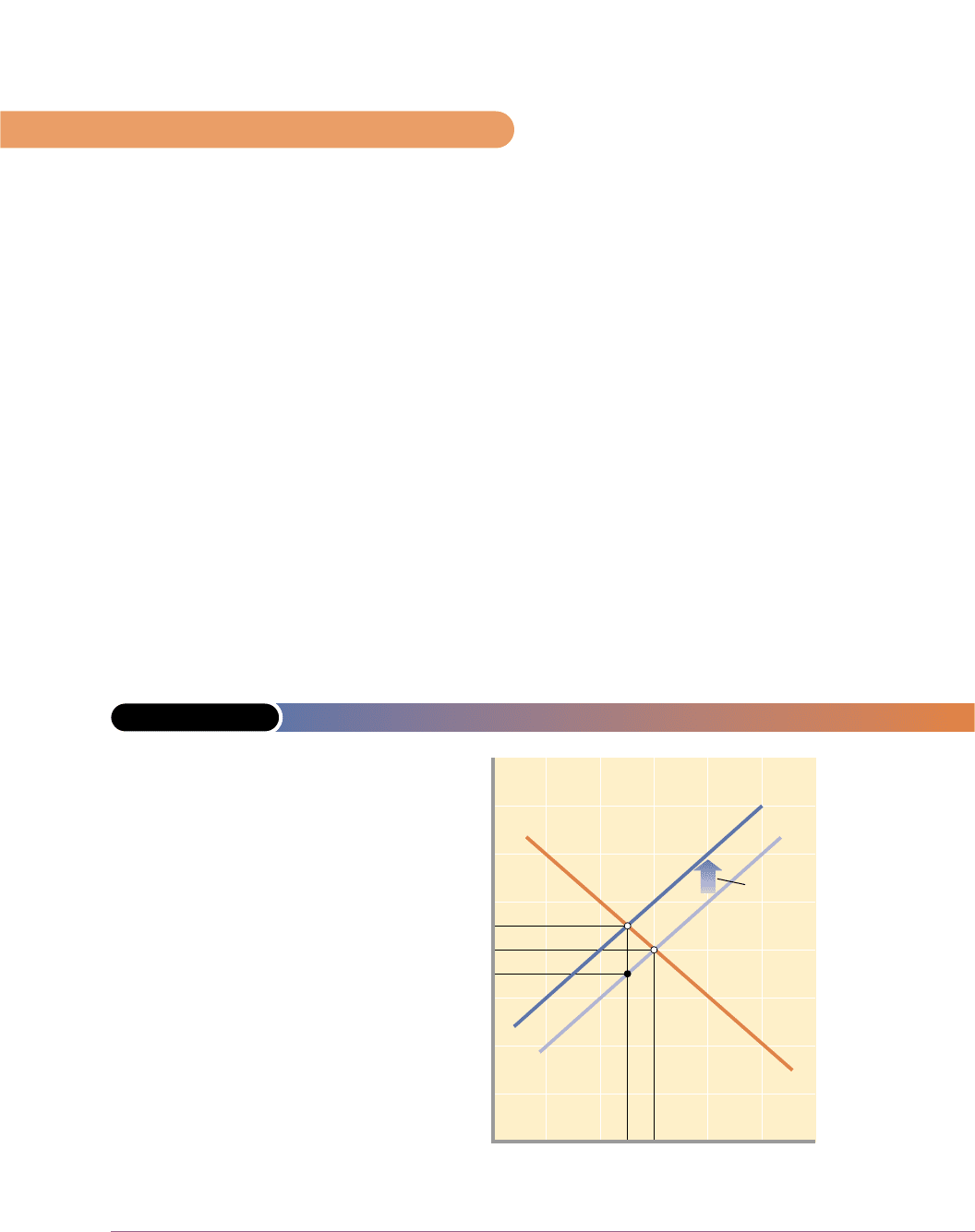
Supply and demand analysis and the elasticity concept are applied repeatedly in the
remainder of this book. Let’s strengthen our understanding of these analytical tools
and their significance by examining elasticity and tax incidence.
Elasticity and Tax Incidence
In Figure 6-4, S and D represent the pretax market for a certain domestic wine from
the Niagara Peninsula. The no-tax equilibrium price and quantity are $4 per bottle
and 15 million bottles. If government levies a tax of $1 per bottle directly on the win-
ery for every bottle sold, who actually pays it?
DIVISION OF BURDEN
Since government places the tax on the sellers (suppliers), the tax can be viewed as
an addition to the marginal cost of the product. Now sellers must get $1 more for
each bottle to receive the same per-unit profit they were getting before the tax. While
sellers are willing to offer, for example, five million bottles of untaxed wine at $2 per
bottle, they must now receive $3 per bottle—$2 plus the $1 tax—to offer the same
five million bottles. The tax shifts the supply curve upward (leftward) as shown in
Figure 6-4, where S
t
is the after-tax supply curve.
The after-tax equilibrium price is $4.50 per bottle, whereas the before-tax price
was $4.00. So, in this case, half the $1 tax is paid by consumers as a higher price; the
other half must be paid by producers in a lower after-tax per-unit revenue. That is,
after paying the $1 tax per unit to the government, producers receive $3.50, or 50¢
chapter six • supply and demand: elasticities and government-set prices 143
FIGURE 6-4 THE INCIDENCE OF A TAX
Tax $1
S
t
S
D
$6
5
4
3
2
1
0
510152025
Q
P
Quantity
(millions of bottles per month)
Price (per bottle)
A tax of a specified
amount per unit
levied on producers,
here $1 per unit,
shifts the supply
curve upward by the
amount of the tax per
unit: the vertical dis-
tance between S and
S
t
. This shift results in
a higher price (here
$4.50) to the con-
sumer and a lower
after-tax price (here
$3.50) to the pro-
ducer. Thus,
consumers and pro-
ducers share the
burden of the tax in
some proportion
(here equally at $.50
per unit).
Elasticity and Taxes
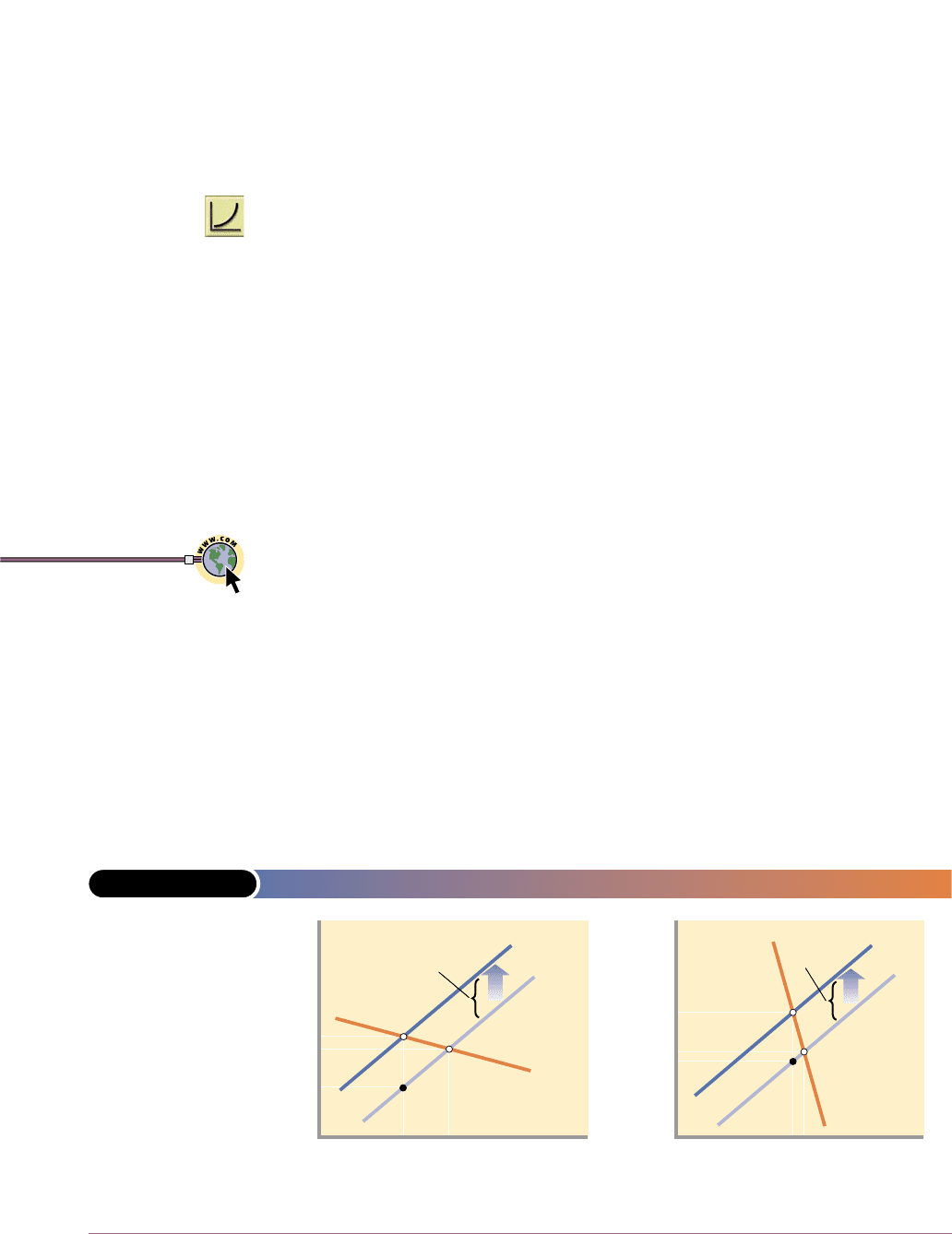
less than the $4.00 before-tax price. In this instance, consumers and producers share
the burden of this tax equally; producers shift half the tax to consumers in a higher
price and bear the other half themselves.
Note also that the equilibrium quantity decreases as a result of the tax levy and
the higher price it imposes on consumers. In Figure 6-4, that decline in quantity is
from 15 million bottles per month to 12.5 million bottles per month.
ELASTICITIES
If the elasticities of demand and supply were different from those shown in Figure
6-4, the incidence of tax would also be different. Two generalizations are relevant.
First, with a specific supply, the more inelastic the demand for the product, the larger the
portion of the tax shifted to consumers. To verify this, sketch graphically the extreme
cases where demand is perfectly elastic or perfectly inelastic. In the first case, the
incidence of the tax is entirely on sellers; in the second, the tax is shifted entirely to
consumers.
Figure 6-5 contrasts the more usual cases where demand is either relatively elas-
tic or relatively inelastic in the relevant price range. With elastic demand, shown in
Figure 6-5(a), a small portion of the tax (P
e
– P
1
) is shifted to consumers and most of
the tax (P
1
– P
2
) is borne by the producers. With inelastic demand, shown in Figure
6-5(b), most of the tax (P
i
– P
1
) is shifted to consumers and only a small amount
(P
1
– P
b
) is paid by producers. In both graphs the per-unit tax is represented by the
vertical distance between S
t
and S.
Note also that the decline in equilibrium quantity (Q
1
– Q
2
) is smaller when
demand is more inelastic, which is the basis of our previous applications of the elas-
ticity concept: Revenue-seeking legislatures place heavy excise taxes on liquor, cig-
arettes, automobile tires, telephone service, and other products whose demands are
thought to be inelastic. Since demand for these products is relatively inelastic, the
tax does not reduce sales much, so the tax revenue stays high.
Second, with a specific demand, the more inelastic the supply, the larger the portion of
the tax borne by producers. When supply is elastic, as in Figure 6-6(a), most of the tax
(P
e
– P
1
) is shifted to consumers, and only a small portion (P
1
– P
a
) is borne by sell-
ers. But when supply is inelastic, as in Figure 6-6(b), the reverse is true; the major
144 Part Two • Microeconomics of Product Markets
FIGURE 6-5 DEMAND ELASTICITY AND THE INCIDENCE OF A TAX
P
P
e
P
a
P
1
0
Q
1
Q
0
Q
a
c
b
(a) Tax incidence and elastic
demand
P
P
i
P
b
P
1
0
Q
2
Q
1
Q
(b) Tax incidence and inelastic
demand
a
c
b
S
t
S
D
i
Tax
Tax
S
t
S
D
e
Panel (a): If demand
is elastic in the rele-
vant price range,
price rises modestly
(P
1
to P
e
) when a tax
is levied. Hence, the
producer bears most
of the tax burden.
Panel (b): If demand
is inelastic, the price
to the buyer will
increase substantially
(P
1
to P
i
) and most of
the tax will be shifted
to consumers.
<economics.about.com/
money/economics/library/
weekly/aa070897.htm>
Some simple economics
of the tobacco deal
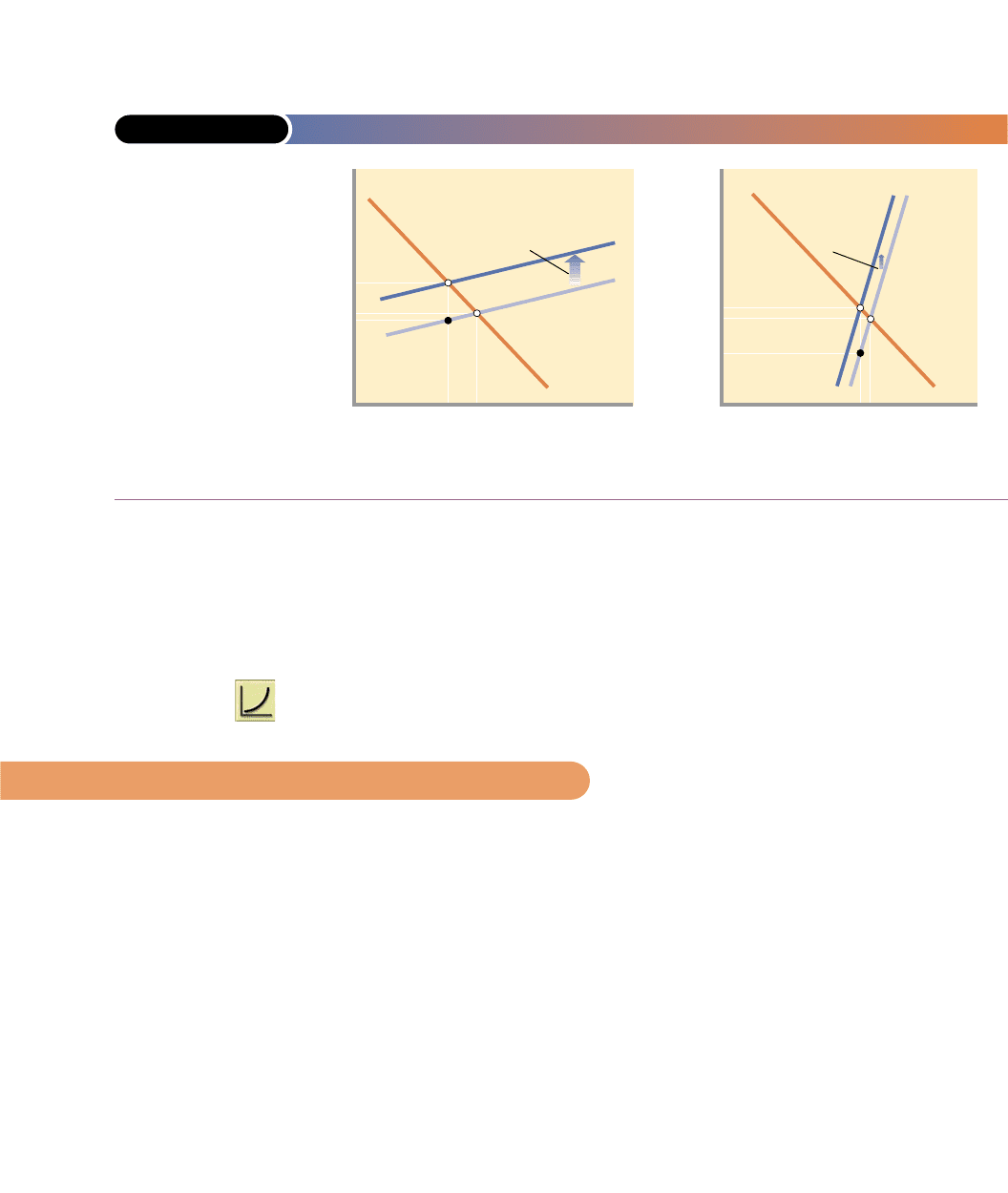
portion of the tax (P
1
– P
b
) falls on sellers, and a relatively small amount (P
i
– P
1
) is
shifted to buyers. The equilibrium quantity also declines less with an inelastic sup-
ply than it does with an elastic supply.
Gold is an example of a product with an inelastic supply, one where the burden
of a tax would mainly fall on producers. Conversely, because the supply of baseballs
is elastic, producers would pass on to consumers much of a tax on baseballs.
You may want to reverse the analysis and assume that the government levies a
(sales) tax on consumers. (Key Question 14)
We turn now to another major supply and demand topic of our chapter: the impli-
cations of government-set prices. On occasion the public and the government con-
clude that supply and demand have resulted in prices that are either unfairly high
to buyers or unfairly low to sellers. In such instances the government may intervene
by legally limiting how high or low a price may go.
Price Ceilings and Shortages
A price ceiling is the maximum legal price a seller may charge for a product or serv-
ice. A price at or below the ceiling is legal; a price above it is not. The rationale for
establishing price ceilings (or ceiling prices) on specific products is that they pur-
portedly enable consumers to obtain some essential good or service that they could
not afford at the equilibrium price. Examples are rent controls and usury laws,
which specify maximum prices in the forms of rent and interest that can be charged
to borrowers. Also, the government has at times imposed price ceilings either on all
products or on a very wide range of products—so-called price controls—to try to
restrain inflation. Price controls were invoked during World War II and in the 1970s.
GRAPHICAL ANALYSIS
We can easily demonstrate the effects of price ceilings graphically. Let’s suppose
that rapidly rising world income boosts the purchase of automobiles and shifts the
chapter six • supply and demand: elasticities and government-set prices 145
FIGURE 6-6 SUPPLY ELASTICITY AND THE INCIDENCE OF A TAX
P
P
e
P
a
P
1
0
Q
1
Q
0
Q
(a) Tax incidence and elastic
supply
P
P
i
P
b
P
1
0
Q
1
Q
0
Q
(b) Tax incidence and inelastic
supply
a
c
b
S
t
S
D
Tax
Tax
a
c
b
S
t
S
D
Panel (a): With an
elastic supply an
excise tax results in a
large price increase
(P
1
to P
e
), and the
tax is therefore paid
mainly by consumers.
Panel (b): If supply is
inelastic, the price
rise is small (P
1
to P
i
),
and sellers will
have to bear most
of the tax.
Government-Set Prices
price ceiling
A legally estab-
lished maximum
price for a good or
service.
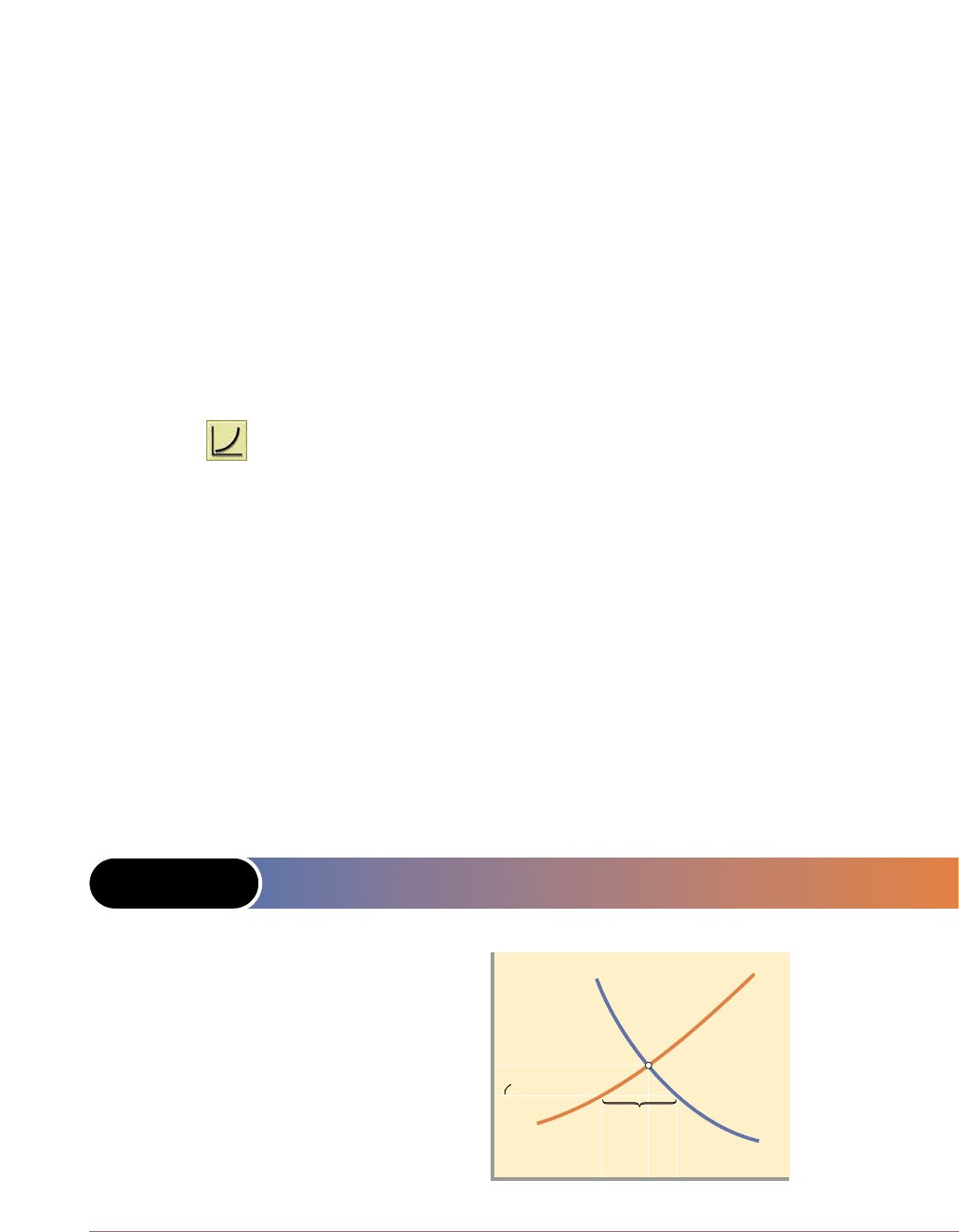
demand for gasoline to the right so that the equilibrium or market price reaches
$1.25 per litre, shown as P
0
in Figure 6-7. The rapidly rising price of gasoline greatly
burdens low-income and moderate-income households who pressure government
to “do something.” To keep gasoline affordable for these households, the govern-
ment imposes a ceiling price, P
c
, of $.75 per litre. To be effective, a price ceiling must
be below the equilibrium price. A ceiling price of $1.50, for example, would have no
immediate effect on the gasoline market.
What are the effects of this $.75 ceiling price? The rationing ability of the free
market is rendered ineffective. Because the ceiling price, P
c
, is below the market-
clearing price, P
0
, there is a lasting shortage of gasoline. The quantity of gasoline
demanded at P
c
is Q
d
and the quantity supplied is only Q
s
; a persistent excess
demand or shortage of amount Q
d
– Q
s
occurs.
The important point is that the price ceiling, P
c
, prevents the usual market adjust-
ment in which competition among buyers bids up price, inducing more production
and rationing some buyers out of the market. That process would continue until the
shortage disappeared at the equilibrium price and quantity, P
0
and Q
0
.
By preventing these market adjustments from occurring, the price ceiling poses
problems born of the market disequilibrium.
RATIONING PROBLEM
How will the government apportion the available supply, Q
s
, among buyers who
want the greater amount Q
d
? Should gasoline be distributed on a first-come, first-
served basis, that is, to those willing and able to get in line the soonest and to stay
in line? Or should gas stations distribute it on the basis of favouritism? Since an
unregulated shortage does not lead to an equitable distribution of gasoline, the gov-
ernment must establish some formal system for rationing it to consumers. One
option is to issue ration coupons, which authorize bearers to purchase a fixed
amount of gasoline per month. The rationing system would entail first the printing
of coupons for Q
s
litres of gasoline and then the equitable distribution of the
coupons among consumers so that the wealthy family of four and the poor family
of four both receive the same number of coupons.
146 Part Two • Microeconomics of Product Markets
FIGURE 6-7 A PRICE CEILING RESULTS IN A PERSISTENT
SHORTAGE
Shortage
P
0
Ceiling
Q
s
Q
d
Q
0
Q
P
c
P
0
$.75
$1.25
S
D
A price ceiling is a
maximum legal price,
such as P
c
, that is
below the equilibrium
price. It results in a
persistent product
shortage, here shown
by the distance
between Q
d
and Q
s
.
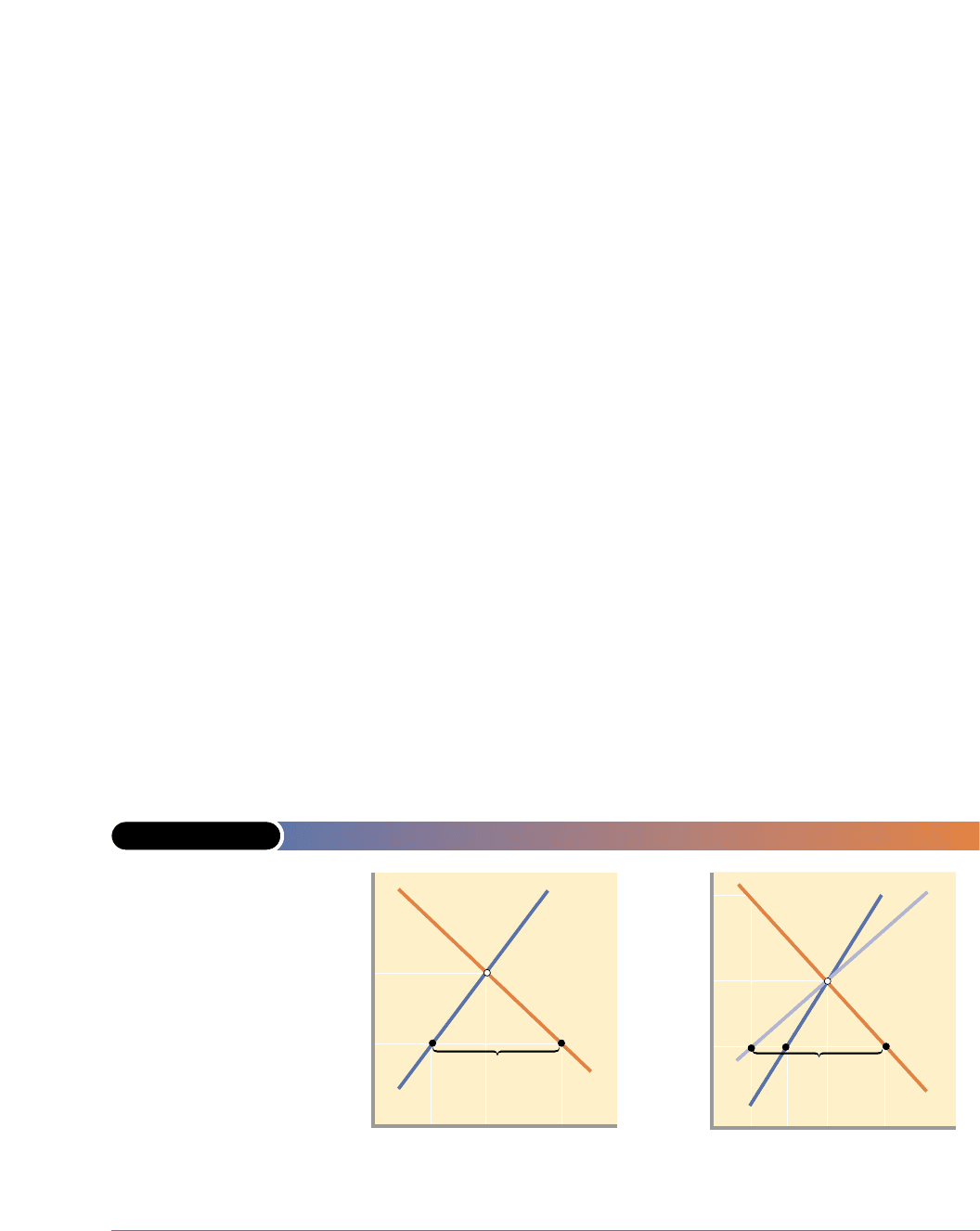
BLACK MARKETS
Ration coupons would not prevent a second problem from arising. The demand
curve in Figure 6-7 tells us that many buyers are willing to pay more than the ceiling
price P
c
, and, of course, it is more profitable for gasoline stations to sell at prices
above the ceiling. Thus, despite the sizable enforcement bureaucracy that will accom-
pany the price controls, black markets in which gasoline is illegally bought and sold
at prices above the legal limits will flourish. Counterfeiting of ration coupons will
also be a problem, and since the price of gasoline is now set by the government, there
would be political pressure on governments to set the price even lower.
RENT CONTROLS
Rent controls are maximum rents established by law (and recently, rent controls
have set maximum rent increases for existing tenants). Such laws are well intended;
their goals are to protect low-income families from escalating rents caused by per-
ceived housing shortages and to make housing more affordable to the poor.
When controls are first imposed, they usually restrict increases in rents above cur-
rent levels. The short-run supply curve for rental accommodation is inelastic
because it takes landlords some time to react to price changes and bring new units
on the market. Most tenants benefit, since the quantity of rental accommodation cur-
rently on the market or under construction is not significantly affected. Thus, the
program appears to be successful even if shortages begin to appear. Figure 6-8 por-
trays a market for rental accommodation with rents fixed at R
c
and a short-run sup-
ply curve, S
s
. A shortage Q
1
– Q
2
exists in the short run.
In the long run the shortage of rental accommodation will worsen since the sup-
ply of rental accommodation becomes more elastic. Construction of new units
decreases and landlords try to convert existing units to other uses or allow them to
deteriorate. The supply curve becomes more elastic in the long run, shown by S
L
in
Figure 6-8(b), making the shortage worse, and increasing it to Q
1
– Q
3
.
The gradually worsening shortage in the long run leads to several related prob-
lems. As in the case of controls on food prices, a black market will emerge. The black
chapter six • supply and demand: elasticities and government-set prices 147
FIGURE 6-8 RENT CONTROLS
S
S
Q
2
Q
1
Q
0
Q
2
Q
3
R
c
R
0
R
c
R
1
R
1
Q
1
Q
0
Short-run
shortage
Long-run
shortage
(a) Short run
(b) Long run
Quantity of rental accommodation
Quantity of rental accommodation
D
D
S
S
S
L
Rent (R)
Rent (R)
In the short run (panel
a) the supply for rental
accommodation is
inelastic. If rent controls
are set at R
c
, a shortage
of Q
1
– Q
2
will occur in
the short run. In the long
run (panel b), supply
becomes more elastic
as landlords are able to
add or withdraw rental
units from the market. In
the long run the shortage
will worsen to Q
1
– Q
3
.
On the black market,
rents of as much as R
1
will be charged.
black
markets
Markets in which
products are ille-
gally bought and
sold at prices above
the legal limits.

market in rental accommodation is often characterized by the charging of “key
money.” Prospective tenants are often forced to bribe a landlord or a subletting ten-
ant to acquire a particular rental unit. The acceptance of key money is illegal in most
jurisdictions with rent controls, but the practice is difficult to stamp out because it is
to the advantage of both parties. Those desperate for rental accommodation will have
to pay the black market rate of as much as R
1
, shown in Figure 6-8(b).
Another problem that results from controls is the emergence of a dual rental mar-
ket if new buildings are exempt from controls. Apartment units whose rents are
below market levels are almost always rented informally or with some form of key
money attached. The units that have recently come on the market will be offered at
rents above the levels that would exist without controls as landlords attempt to
compensate for future restrictions on rent increases. Because of discrimination by
landlords and the ability to pay key money, middle-class tenants will find it easier
to secure units in the controlled market, while the poor will be forced to seek units
in the uncontrolled market. Perversely, tenants with higher incomes can be the
major beneficiaries of the program.
Rent controls distort market signals and misallocate resources. Too few resources
are allocated to rental housing, too many to alternative uses. Ironically, although
rent controls are often legislated to lessen the effects of perceived housing shortages,
controls are a primary cause of such shortages.
CREDIT CARD INTEREST CEILINGS
Over the years there have been many calls for interest-rate ceilings on credit card
accounts. The usual rationale for interest-rate ceilings is that the banks and retail
stores issuing such cards are presumably taking unfair advantage of users and, in par-
ticular, lower-income users by charging interest rates that average about 18 percent.
What might be the responses to government imposing a below-equilibrium interest
rate on credit cards? The lower interest income associated with a legal interest ceiling
would require the issuers of cards to reduce their costs or enhance their revenues:
● Card issuers might tighten credit standards to reduce losses due to non-
payment and collection costs. Then, low-income people and young people
who have not yet established their creditworthiness would find it more diffi-
cult to obtain credit cards.
● The annual fee charged to cardholders might be increased, as might the fee
charged to merchants for processing credit card sales. Similarly, card users
might be charged a fee for every transaction.
● Card users now have a post-purchase grace period during which the credit
provided is interest-free. That period might be shortened or eliminated.
● Certain “enhancements” that accompany some credit cards (for example,
extended warranties on products bought with a card) might be eliminated.
● Retail stores that issue their own cards might increase their prices to help off-
set the decline of interest income; customers who pay cash would in effect be
subsidizing customers who use credit cards.
Price Floors and Surpluses
Price floors are minimum prices fixed by the government. A price at or above the
price floor is legal; a price below it is not. Price floors above equilibrium prices are
usually invoked when society believes that the free functioning of the market
148 Part Two • Microeconomics of Product Markets
price
floors
Legally
determined prices
above equilibrium
prices.
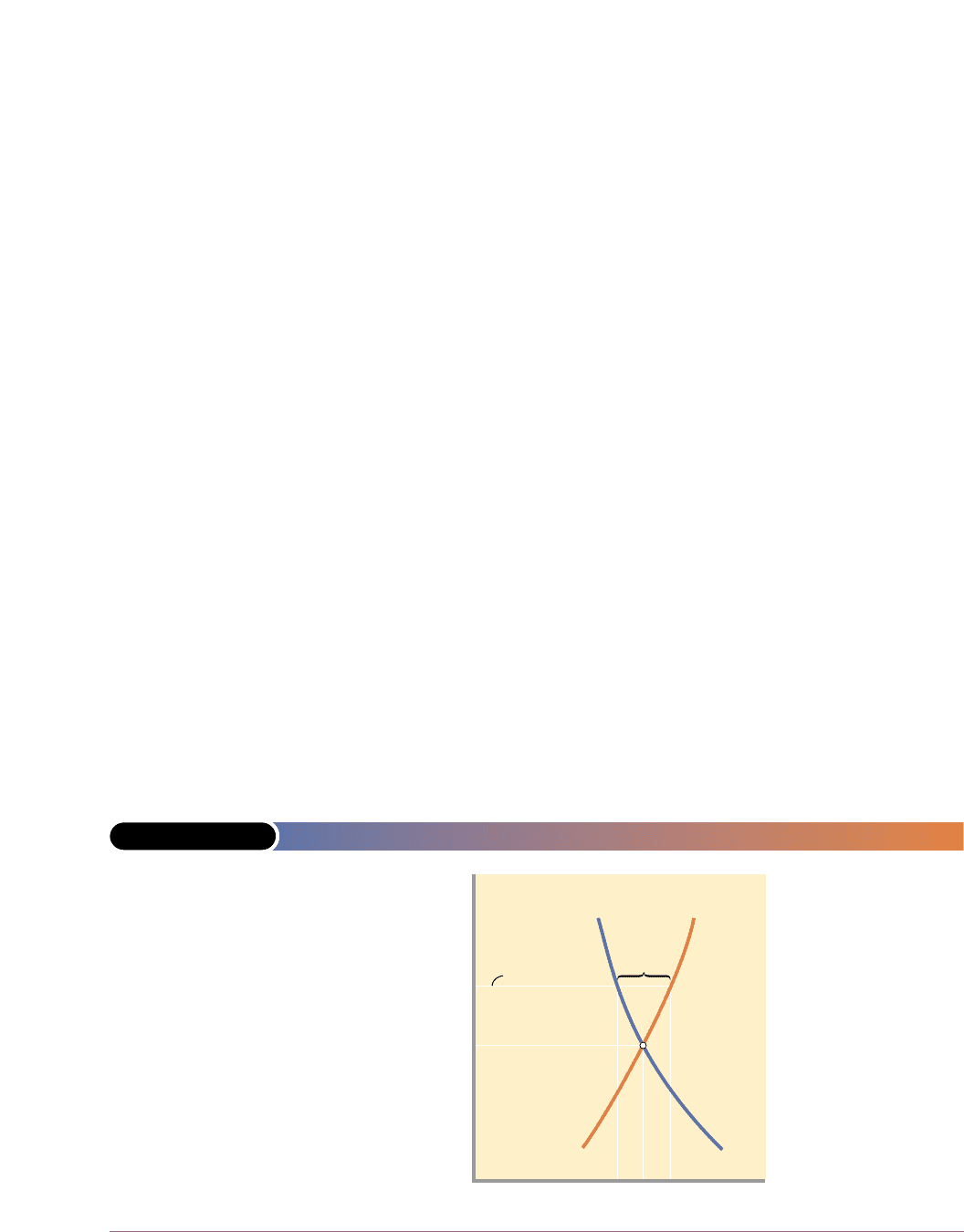
system has not provided a sufficient income for certain groups of resource suppli-
ers or producers. Formerly supported prices for agricultural products and current
minimum wages are two examples of price (or wage) floors. Let’s look at the former.
Suppose the equilibrium price for wheat is $3 per bushel and, because of that low
price, many farmers have extremely low incomes. The government decides to help
by establishing a legal price floor or price support of $4 per bushel.
What will be the effects? At any price above the equilibrium price, quantity sup-
plied will exceed quantity demanded—that is, there will be a persistent excess sup-
ply or surplus of the product. Farmers will be willing to produce and offer for sale
more than private buyers are willing to purchase at the price floor. As we saw with a
price ceiling, an imposed legal price disrupts the rationing ability of the free market.
Figure 6-9 illustrates the effect of a price floor. Suppose that S and D are the sup-
ply and demand curves for corn. Equilibrium price and quantity are P
0
and Q
0
,
respectively. If the government imposes a price floor of P
f
, farmers will produce Q
s
,
but private buyers will purchase only Q
d
. The surplus is the excess of Q
s
over Q
d
.
The government can cope with the surplus resulting from a price floor in only
two ways:
1. It can restrict supply (for example, by asking farmers to agree to take a certain
amount of land out of production) or increase demand (for example, by research-
ing new uses for the product involved). These actions may reduce the difference
between the equilibrium price and the price floor and thereby reduce the size of
the resulting surplus.
2. The government can purchase the surplus output at the $4 price (thereby subsi-
dizing farmers) and store or otherwise dispose of it.
Controversial Tradeoffs
In a free market, the competitive forces match the supply decisions of producers and
the demand decisions of buyers, but price ceilings and floors interfere with such an
outcome. The government must provide a rationing system to handle product
chapter six • supply and demand: elasticities and government-set prices 149
FIGURE 6-9 A PRICE FLOOR RESULTS IN A PERSISTENT SURPLUS
P
f
P
0
Surplus
Floor
P
Q
d
Q
0
Q
s
0
Q
S
D
$2.00
$3.00
A price floor is a
minimum legal price,
such as P
f
, which
results in a persistent
product surplus, here
shown by the hori-
zontal distance
between Q
s
and Q
d
.
